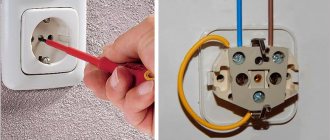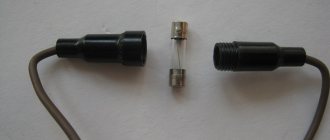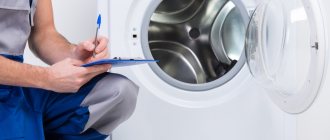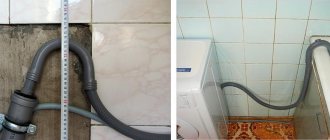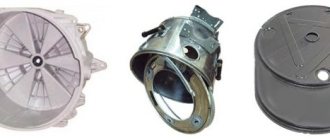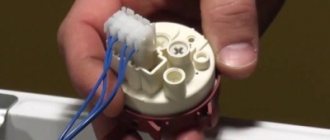What should you do if, after a certain period of proper operation, your machine or RCD in the electrical panel starts to trip when you turn on the washing machine?
Not everyone wants to immediately run to a service center, especially when the warranty has already expired. And transporting such large equipment is not an ordinary task.
In most cases, you can identify the breakdown and eliminate the cause yourself. The main thing is to know what to check and how.
Moreover, with a competent approach, it is possible to identify the cause of the shutdown even without special measuring instruments. There are several common symptoms and cases, let's look at them in order.
Damage in the wiring - the washing machine is not to blame
Where to start troubleshooting? Firstly, you don’t need to immediately climb in and disassemble the machine. Maybe it has nothing to do with it at all, but the socket, wiring or the machine itself is to blame.
How to find out? Connect a load of approximately the same power to the same outlet. For example, an electric kettle and see how the machine behaves.
If he knocks it out again, then the washing machine has nothing to do with it. You need to look for damage:
- in the socket
- in the wiring
- in a machine, RCD or panel
If nothing turns off, then most likely the machine is to blame. To make sure of this 100%, temporarily connect it from a portable outlet from another outlet that is not connected to the bathroom line.
True, several conditions must be met here:
- this should be a short-term option, just for testing
The SMA cannot be permanently connected through a carrier.
- such an extension cord must have grounding contacts
- the protection device of the other outlet must correspond to the rating of the bathroom line
- the plug must be installed in exactly the same way, that is, you need to guess the phase and zero
The fact is that if you turn the plug 180 degrees, the protection often stops triggering.
For a faulty washing machine, it turns out that there is a difference where the phase is supplied and where the zero is supplied.
Sometimes people “treat” their problems this way. Although the device cannot be turned on for a long time in this operating mode.
Only if all the above conditions are met, in the event of a malfunction of the washing machine itself, another machine or RCD will trip.
By the way, when you do not have a dedicated line to the bathroom, and there are other sockets on the same circuit breaker, before all manipulations and checks, be sure to turn off all extraneous loads.
Suddenly it turns out that the reason is not the washing machine at all, but other equipment connected in parallel.
So, if you find out that without the machine in the outlet, nothing turns off. We are looking for a leak or short circuit before it.
Turn off the machine, check that there is no voltage in the outlet and disassemble it for visual inspection.
It is very important that only waterproof sockets are used for washing machines in the bathroom. Otherwise, oxidation of the contacts and constant tripping of the RCD or automatic circuit breaker are guaranteed.
When opening a simple socket, all its contacts and the housing itself will be constantly wet. In this case, the RCD may spontaneously trip even at idle, when nothing is connected in the bathroom.
In order to somehow work with such an outlet, you will have to constantly keep the exhaust fan on in the bathroom.
Also, condensation often forms inside machines with a washing temperature of no more than 40 degrees. With this mode and when rinsing in cold water, droplets of moisture first settle on the inner walls and then reach the electrical contacts.
If there is damage in the outlet, you will definitely see it by soot and burnt contacts.
Well, if you don’t find anything suspicious here, then check the cable.
In a good way, this is done with a special device - a megohmmeter.
The ends on both sides of the cable are unscrewed and the insulation is caused.
The problem is that not even all electricians have such a measuring device at home. What can we say about ordinary consumers?
How can we manage without it? A modern home electrical panel in most apartments and private houses no longer consists of just two switching devices or plugs.
It contains at least ten switching devices, or even more.
All you need to check is to transfer the cable going to the outlet in the bathroom under the washing machine to another protective device of a similar rating.
To do this, for greater safety, turn off the common input and check that there is no voltage in the switchboard.
Next, unscrew the phase conductor from the terminal of the washing machine and transfer it to another protective device of the same rating.
Having first removed the original cable from it, which goes to another load. Turn on the input and the “new automatic” protection. Again, check everything by turning on the load in the form of a kettle in the bathroom.
Normal power supply
Power test circuit
If your other machine is knocked out, it means there is a defect in the wiring. You will have to check the entire chain, open all junction boxes, etc.
Read more about the steps of this check in the article below.
By the way, an RCD in such cases can often trip simply due to a weakened zero in the switchboard itself. You will run around the whole room, open the wallpaper, and the reason will be right under your nose. Don't rule out this option either.
If, after switching to the new device, everything works properly, then change the original switch. Most likely, the contacts in it have burnt out and it no longer holds its rated load.
Common RCD faults
The residual current device contains moving parts. The mechanics of cheap models are not reliable. If the RCD is introductory, the current of all consumers in the apartment flows through it, which inevitably leads to heating of the terminals and relay contacts. These factors contribute to the safety device being knocked out.
The "test" button is broken
The “text” button is used to check the functionality of the RCD. But often it leads to its malfunction. The safety device should be checked every month. Due to frequent testing, the “test” button is subject to a number of negative factors:
- jamming from too much pressure or dust;
- breakdown of moving parts;
- dirt getting on the conductive contacts of the button.
The activation mechanism is broken
It does not require much effort to turn off the RCD. The lever acts on a special latch that releases the contacts. After which the device turns off. If there is a breakdown in this mechanism, then involuntary tripping of the RCD is possible.
The problem often appears when it gets hot. Under the influence of heat, the parts of the mechanism change their geometric dimensions, which leads to the release of the latch and disconnection of the RCD. Another triggering factor is vibration. If the mechanism is on the edge, it will work even with light taps. If the lever itself or the rods break down, the RCD simply does not turn on.
Current leakage inside the RCD
A common cause of such a malfunction is dust and moisture entering the protective device. This leads to leakage currents in the RCD itself. Dirt can transfer electricity between any conductive parts and even supply phase voltage to the device controller, which will lead to burnout of the electronics.
Checking the functionality of the RCD
The malfunction is typical for devices located not in the shield, but in the open air. In some cases, to correct the situation, it is enough to remove the protective device and let it dry thoroughly at temperatures of 30-50°C. If drying helps, then the problem is moisture. In the future, it is necessary to protect the device from water.
Triggering of RCDs from some household appliances
Many household and industrial devices are equipped with filter capacitors between the power wires and the device body. For example, PC system units. The presence of capacitors causes leakage current to ground. Usually it is small enough that the RCD will not be knocked out. However, if there are enough such devices, the leakage currents on the grounded housings of household appliances will add up and lead to the operation of the protective device.
This most likely refers not to a malfunction of the RCD, but to incorrect selection
When choosing a protective device, you should pay attention to the current IDn at which it turns off
Incorrect connection of the protective device
Connection errors are detected immediately after installation of the RCD or other electrical equipment. For example, a previously installed protective device began to break after connecting the socket. So that's the problem
It is necessary to pay attention to the connection of the phase, neutral and ground wires into sockets
Another option is to knock out a new, newly installed RCD. The previous protective device worked correctly. No changes were made to the apartment wiring. In such a situation, you should check the connection of the new RCD. Even experienced craftsmen make mistakes.
Causes of failure in the washing machine
Now let's look at the reasons when the malfunction is related to the washing machine itself.
There are many more damage options here:
- short circuit or breakdown of heating element
- defective plug or cable in the machine itself
This is most often visible even visually. It is enough to carefully examine all contacts on both sides.
You won't be able to disassemble the fork; it comes cast. But the integrity of the insulation can be traced.
- engine damage (water entered due to leaky gaskets)
- faulty line filter or control board
You should always start your search with the most common breakdown - a malfunction of the heating element. In 2/3 of cases, it is because of this that the machine and the RCD are turned off.
Again, everything can be revealed without instruments. How to do it?
Damaged cable
Another reason for the RCD to trip is a faulty power cable. A sign of a wire short circuit is when the protection turns on when the washing machine starts. In order to check the power cord, you must turn off the device from the network. We take out the entire cable and inspect it.
If the reason for the machine being knocked out is the cable, then traces of a malfunction will be visible to the naked eye. Melted areas and soot are signs of a short circuit. In such a situation, the wire should be replaced completely. If you have no experience working with electrical equipment, you should contact washing machine repair specialists who will connect a new cable and conduct additional diagnostics of the equipment.
Checking the heating element in a washing machine without a multimeter
First of all, do not forget about safety precautions and before any work inside the machine, not only turn off the machine in the panel, but also pull out the power plug from the socket.
Next, remove the back or front cover (depending on the design) to get to the contacts of the heating element. The heating element will be located at the bottom.
The phase and neutral are suitable at the edges, and in the middle there is grounding.
When you don’t even have a multimeter at hand, to check the heating element, simply remove the phase and neutral conductors and insulate them.
Now plug the washing machine into the socket and turn on the machine. If the machine starts and the machine stops knocking out, then change the heating element.
It was he who caused the malfunction.
However, keep in mind that some SMAs do not work without a heating element. They have it connected in the same circuit with the water supply valve. In this case, unfortunately, there is no way to do without a tester.
Installation and wiring requirements
At the slightest doubt in their abilities regarding the high-quality installation of an RCD, prudent people prefer to entrust such a responsible process to a qualified electrician
What points should a professional pay attention to:
- The compatibility of household wiring with the power of the washing unit is determined. If for some reason there are no documents for the machine, the mentioned technical characteristics can be found from the information block on its back wall.
- When it is determined that the unit is connected to the network with a two-core or aluminum wire, the latter is replaced with a copper and three-core wire with a cross-section of 2.5 square meters. mm. The update allows you to safely use the installed socket in the future not only to turn on the washing machine, but also a hair dryer, and any other power tools used in everyday life for personal care.
- The presence of grounding is checked. When using the original plug of the washing machine, if it belongs to the first class in terms of protection against electric shock, no additional measures are taken - everything is built into the plug.
- For safety reasons, a special outlet is installed, designed for use in rooms with excessive humidity.
Tags: machine, sconce, upper, view, harm, engine, house, replacement, protective, sign, cable, like, capacitor, magnet, installation, power, multimeter, load, voltage, connection, rule, principle, wire , start, , work, size, regulator, relay, repair, row, light, network, connection, resistance, ten, current, , filter, photo, shield, electricity, power tool, power supply
Checking the heating element of a washing machine with a multimeter
If you still don’t trust all these experiments and want to be 100% sure that it is the heating element that is damaged and not something else, then your only assistant is a multimeter.
How to properly check the heating element? Again, pull out the plug from the socket, and put the tester in resistance measurement mode.
A measurement scale of up to 200 ohms will be sufficient.
Apply probes to the contacts of the heating element to check its integrity and absence of breakage. In a normal situation, its resistance should be in the range from 20 to 50 Ohms.
If the device shows infinity, then the spiral is broken.
You also need to test it for a short circuit to the body. Apply one probe to the metal part of the heating element or the central bolt where the grounding is located.
And with the others, you alternately touch the phase and neutral terminals.
Any values, even several tens of kiloOhms, indicate that the heating element is broken and must be replaced.
By the way, if there is a simple break in the heating element without shorting it to the housing, the machine will not knock out.
In this case, an error may appear on the display indicating that the water is not heating.
If you do not have a display with a description of the error code, then simply touch the glass on the washer door. Warm water should warm it up a little.
The most common breakdowns in which the machine knocks out the RCD (or machine)
If the traffic jams are knocked out, then most likely something is short-circuited. A very rare but possible case is when a washing machine knocks out the machine due to a large amount of condensation on the electrical elements inside the machine. In this case, it is enough to leave the machine alone for a day or two in a well-ventilated area.
But again, the chance that this is your case is not high. Much more often the following troubles occur with washing machines:
*Please note that the table shows estimated repair costs. The technician will provide you with an accurate estimate for all work after diagnosing the washing machine. Diagnostics are carried out free of charge, but if you refuse repairs, you must pay 400 rubles for a specialist visit.
** Prices are indicated only for the work of the master, without taking into account the cost of spare parts.
What is a difavtomat?
This is a device similar in purpose to an RCD, but with expanded functionality. Because it contains a built-in circuit breaker, the operation of which is the same as that available in the distribution panel common to the house. In addition to triggering a circuit interruption when a leak is detected, the differential circuit breaker protects home appliances connected to the network from overloads that occur in it and the consequences of short circuits on the line.
Expert opinion
I work in the household appliance repair industry. Extensive experience in restoring washing machines and dishwashers.
Ask a Question
That is, its presence guarantees reliable protection against a greater number of problems due to violation of the integrity of the wiring, incorrect use of a switched-on electrical appliance, or changes in voltage for any reason.
Damage to the power cord or plug
Diagnostics always starts with the electrical wire and plug. During operation, the cord is subject to mechanical stress: it is pulled, overlapped, pinched. As a result of damage, the plug and electrical outlet do not make good contact.
Check the wire for damage with a multimeter. Replacing the power cord is as follows:
- it is necessary to turn off the power to the washing machine and close the inlet valve;
- use a hose to drain the water (turning the washing machine over is strictly prohibited);
- Unscrew the screws located around the perimeter and remove the panel;
- remove the surge protector from the housing by unscrewing the screw;
- press the latches, remove the plastic stopper by squeezing it out;
- move the electrical wire inward and to the side, thereby gaining access to the filter and disconnecting it;
- carefully pull out the power cord from the machine;
To install a new cord, you need to perform these steps in reverse order.


